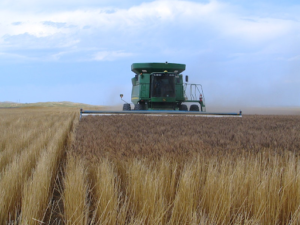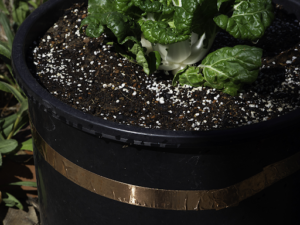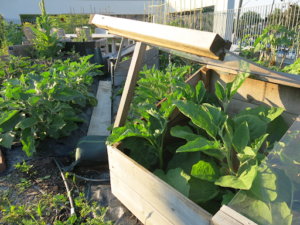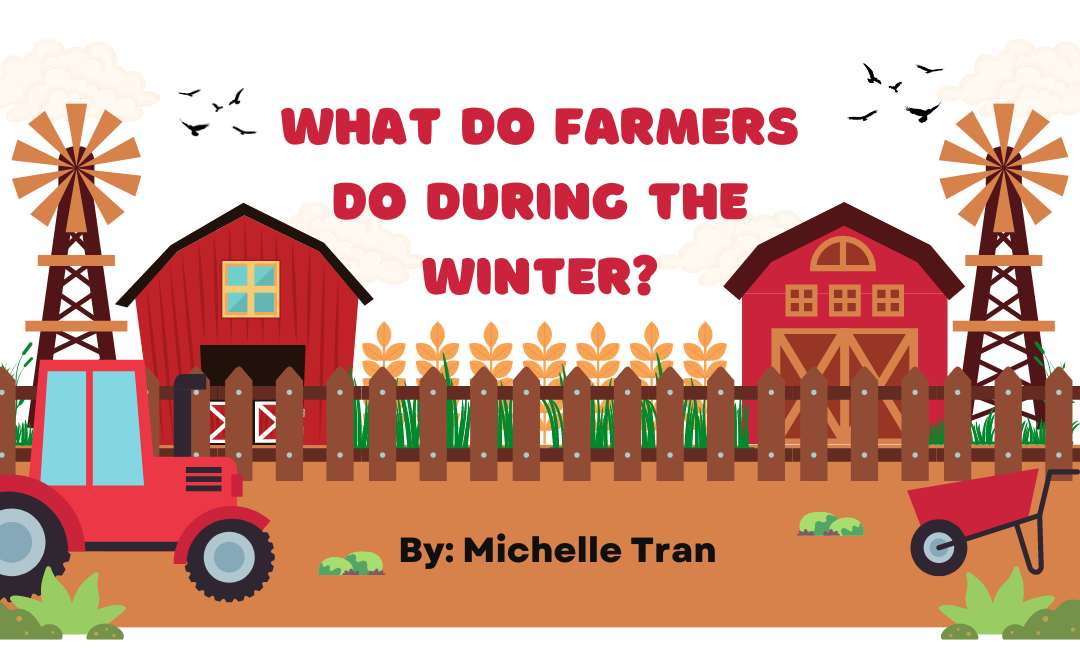Written by: Michelle Tran
Edited by: Advita
Designed by: Alessa Zaitseva
Published by: Rayna
 We all know that farmers use spring as a preparation period for their crops, summer to allow their crops to grow, and the best season of all, fall for harvesting and maintaining crops. Farmers work during the usual three seasons, minus winter, to prepare the food we buy at the produce section of grocery stores, but what necessarily do farmers do during the winter time?
We all know that farmers use spring as a preparation period for their crops, summer to allow their crops to grow, and the best season of all, fall for harvesting and maintaining crops. Farmers work during the usual three seasons, minus winter, to prepare the food we buy at the produce section of grocery stores, but what necessarily do farmers do during the winter time?
What Exactly Do Farmers Do in Winter?
In Canada, winter is the coldest time of the year. This term usually begins in December and ends in February. It is also the time when snow falls, freezing temperatures arise, and crops are unable to grow. Depending on the crop, it may not even survive during winter. However, when these conditions come into play while farming, farmers are still able to be productive when winter comes along. Farmers use the wintertime to plan yield maps for the upcoming season, and pack harvest crops, and depending on the crops they plant, they may also use this time to harvest them. Farmers also use the wintertime to ensure creature and crop comfort.
Planning & Selling
 Farmers still work in the winter, even if it is not a generic form of farming. Let us note that farmers do not only grow and harvest crops, but they do many things outside of just these two aspects. One of the other things farmers do is plan for the new season, this includes budget and supply planning. Farmers use winter times to pack their produce to sell them in the season, but not all their produce is sold at the same time. Throughout the season, produce left to be packaged is kept for the new season in customized coolers, which are mainly for carrots, potatoes and onions (Coppolino, 2022).
Farmers still work in the winter, even if it is not a generic form of farming. Let us note that farmers do not only grow and harvest crops, but they do many things outside of just these two aspects. One of the other things farmers do is plan for the new season, this includes budget and supply planning. Farmers use winter times to pack their produce to sell them in the season, but not all their produce is sold at the same time. Throughout the season, produce left to be packaged is kept for the new season in customized coolers, which are mainly for carrots, potatoes and onions (Coppolino, 2022).
Winter Crops
Some crops can withstand wintertime conditions, but they’re not grown directly on the soil that many think they’re grown in. For these crops to grow, they need to be protected so no factors affect the process of growth. These crops are grown in structures like cold frames, mini hoop tunnels, greenhouses, or polytunnels (Jabbour, n.d.). Crops that can grow in wintertime include wheat, kale, lettuce, carrots, asian greens, scallions, mache, and many more. However, the majority of these are cold-tolerant crops which are vegetables and greens.
Crop Comfort
Winter-time also gives farmers the time to reflect on their past-season procedures. It helps them to identify errors or improvements they could make in the next season. Even with this, farmers need to ensure their crops are comfortable in the state they’re in during winter. Plants should be properly taken care of despite the conditions of the season (Coppolino, 2022), which is why the comfort of these plants is so important. Equipment is also checked over to ensure it is ready to operate in the next season without any safety or danger issues for both the farmer and consumer. Winter gives farmers the time to ensure all their crops are comfortable and free of complications so that they’re able to be packaged and shipped to markets for people like us to purchase and consume safely.
How Can You Grow Your Winter Crops at Home? – Winter Harvest
 This method of growing crops is called “Winter Harvest.” You can grow winter crops at home by preparing a winter-withstanding structure like a cold frame, mini hoop tunnel, greenhouse, or polytunnel. Once you have a structure, depending on the starting point of the crop, you might straight-up transfer your sprouted plant to the structure of choice. However, if you’re starting from a seed, you want to germinate your seed around the season of mid-summer to early autumn (Jabbour, n.d.). This aids your seed in receiving the right environmental conditions within the best harvest season. Once you have transferred your seed/crop to the structure of your choice, follow regular harvesting regulations for your chosen crop (gardening rules may vary depending on the crop). Please note that it takes time to professionally learn about growing certain crops, extra extensive research should be done outside this blog before performing winter-harvesting at home.
This method of growing crops is called “Winter Harvest.” You can grow winter crops at home by preparing a winter-withstanding structure like a cold frame, mini hoop tunnel, greenhouse, or polytunnel. Once you have a structure, depending on the starting point of the crop, you might straight-up transfer your sprouted plant to the structure of choice. However, if you’re starting from a seed, you want to germinate your seed around the season of mid-summer to early autumn (Jabbour, n.d.). This aids your seed in receiving the right environmental conditions within the best harvest season. Once you have transferred your seed/crop to the structure of your choice, follow regular harvesting regulations for your chosen crop (gardening rules may vary depending on the crop). Please note that it takes time to professionally learn about growing certain crops, extra extensive research should be done outside this blog before performing winter-harvesting at home.
In conclusion, farmers can proceed with their tasks throughout all 365 days a year, it may not be commonly known but a lot of thought goes into growing and harvesting. Winter downtime is used to plan for supplies and budget for next season’s harvest, package and sell crops, ensure plant comfort, and may also be the continuation of winter harvesting. Despite the cold environment, farmers are still able to make the most of their downtime by using it in efficient ways to ensure our produce is safe, healthy, and rich. Let us appreciate our local and global farmers for all the effort they put into the produce we consume. Thank you, farmers!
References
Coppolino, A. (2022, February 12). Winter is not downtime for local farmers who have lots to keep them busy: Andrew Coppolino. CBC. Retrieved November 3, 2023, from https://www.cbc.ca/news/canada/kitchener-waterloo/andrew-coppolino-farmers-in-winter-months-slows-but-doesn-t-stop-farm-chores-1.6346987
Jabbour, N. (n.d.). Vegetables to Grow in Winter: 8 Crops for Winter Harvesting. Savvy Gardening. Retrieved November 3, 2023, from https://savvygardening.com/vegetables-to-grow-in-winter/
Norén, A. (2019, September 17). Planting Pak Choy for Winter Harvest – Tom’s Garden. Frisco Vista. Retrieved November 3, 2023, from https://www.friscovista.com/news/whatever/planting-pak-choy-for-winter-harvest/
Thunderstruck Ag Equipment. (n.d.). Farming in North America. Thunderstruck Ag Equipment. Retrieved November 3, 2023, from https://thunderstruckag.com/blogs/guides/your-2023-harvest-guide-farming-in-north-america
Toronto Urban Growers. (2019, December 27). Season extension. Toronto Urban Growers. Retrieved November 3, 2023, from https://torontourbangrowers.org/season-extension
U.S Department of Agriculture. (n.d.). Harvesting winter wheat using a stripper | Free Photo – Rawpixel. Rawpixel. Retrieved November 3, 2023, from https://www.rawpixel.com/image/3336182/free-photo-image-agriculture-bulldozer-cc0

